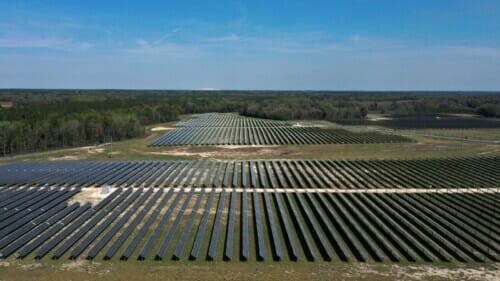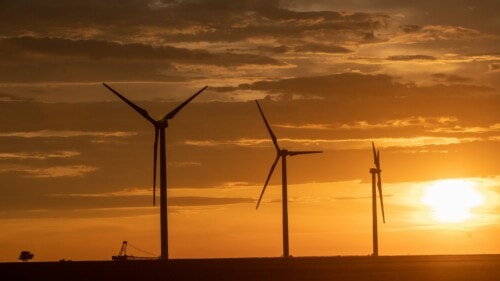Evergy Struggles to Cut Carbon as Energy Demand Soars Sustainability Race Against Climate Change
Published April 4th, 2024 at 6:00 AM
Above image credit: In this Feb. 1, 2021, a smokestack from Evergy's Hawthorn coal-fired power plant is silhouetted against the setting sun in Kansas City. (Charlie Riedel | Associated Press)Evergy, the region’s dominant utility, is promising that more solar and wind power is coming to Kansas City.
But powerful forces are complicating the utility’s plan for a massive shift away from burning coal and natural gas to generate electricity, according to a regulatory filing this week in Jefferson City.
Put simply, the company’s ability to generate electricity is struggling to keep pace with demand.
Panasonic’s decision to build a sprawling electric vehicle battery plant in DeSoto, Kansas, coupled with Google’s recent announcement that it will open a $1 billion data center in Kansas City, will add significantly to area electricity demand.
And those huge local economic development projects are coming at the same time as a dramatic post-COVID surge in energy use in the region, as well as nationally.

Burning Coal
For decades, electricity demand has been flat or declining as Evergy and other utilities brought in an endless parade of freight trains bearing Wyoming coal that belched carbon dioxide when burned for power.
Evergy this week provided a glimpse of its plans for the years ahead.
Today, Evergy now has about 15,650 megawatts of power generating capacity. Over the next 20 years, the company said it needs to increase production by another 5,100 megawatts – nearly one-third of current capacity – using renewable energy from solar and wind sources.
The persistence of Evergy’s reliance on natural gas and coal-fueled power generation concerns environmentalists.
Evergy now gets less than half of its energy from carbon-free sources, primarily the Wolf Creek nuclear plant and renewables. Notably, Kansas is one of the most wind-energy-rich states in the nation.
Evergy Power Sources

Source: Evergy’s 10-K filing with the Security and Exchange Commission.
A slew of national and international developments – and climate change – also are complicating and slowing the move away from fossil fuels.
Local environmentalists are disappointed.
“We can’t take Evergy’s climate goals seriously when the utility slashed its renewable energy investments nearly in half while it plans to add more fossil fuels to the grid than what it is removing by the end of the decade,” said Billy Davies, senior field organizer for the Sierra Club, Missouri Chapter.
Other environmental groups like the National Resource Defense Council (NRDC), while disappointed with Evergy’s posture, recognize that the utility is whipsawed by factors beyond its control.
“Evergy understands the direction we need to go,” said Ashok Gupta, NRDC senior energy economist. “It’s hard stuff to figure out.”
On April 1, Evergy filed its “Integrated Resources Plan” with the Missouri Public Service Commission. A companion filing with the Kansas Corporation Commission is coming next month.
Effect of Climate Change
Ironically, climate change itself may be a factor slowing the greening of the region’s grid.
Winter Storm Uri in mid-February 2021 caused 10 million energy users to be blacked out in the United States and Mexico. Some rolling blackouts extended to our region, well beyond the epicenter of the storm in Texas. Experts contend that the increasing frequency and virulence of weather events is a result of climate change.
As a result of Winter Storm Uri, the utility sector has been asked by federal regional grid overseers to maintain greater reserves of power to deal with future weather disruptions. From the perspective of the organizations that monitor and plan for the future of the regional grid, there also is not enough power available to meet potential demand.
“Retirements are outpacing new installations of resources on the grid and that’s a problem that we haven’t had on the grid since its early formation period in the ‘30s,” Clair Moeller, president and chief operating officer of Midcontinent Independent System Operator (MISO), recently told the U.S. Department of Energy “Grid Talk” podcast.
Meanwhile, grid planners have come under criticism for being too slow to approve new renewable projects.
“We get a lot of critique about our generation interconnection queue being big, slow and ugly,” Moeller said. “But we’ve got over 50,000 megawatts of generation projects, mostly renewable, that had permission to connect to the grid but aren’t being constructed.”
“Over half of those 50,000 megawatts are more than 740 days late,” Moeller said. “And when we ask why that is, the answers we get back is supply chain, dominantly labor as well as materials.”
Meeting New Demand
Meanwhile, major energy consumers like Panasonic and Google, among others, are eager to march ahead with plans to embrace more sustainable forms of energy. They and others are working with Evergy to find a path forward.
It is not always easy.
The New York Times last month pointed to the difficulties Panasonic faces as Evergy deals with its own needs and pressures.
The newspaper reported that, “In Kansas, one utility has postponed the retirement of a coal plant to help power a giant electric-car battery factory.”
The irony was striking. Evergy is pumping up carbon emissions at its Lawrence Energy Center to power a factory in DeSoto making EV car batteries to limit the very same carbon emissions.

Tina Jeffress, Panasonic group manager for sustainability and energy, told Flatland that Evergy decided to use a coal-fired generating facility in Lawrence to burn natural gas “before we came into the region.”
“Panasonic is aggressively net zero. We plan to buy 100 percent renewable energy,” she said. “I am in conversations on a daily basis with energy developers. I talk to Evergy four or five times a week.”
Panasonic is clear as to its path.
“We decided to do an all-electric facility. To use gas, we would need a new gas line and we were not going to do that.”
“We are fully committed to decarbonization. We expect it of all our partners as well,” Jeffress said. “We’d like to see more renewable energy in the state.”
Renewable Energy Hopes
Panasonic is monitoring developments such as NextEra Energy’s proposed solar West Gardner Solar project in Kansas, and Evergy’s own talks with the city of Kansas City, Missouri, about plans to develop the largest municipally inspired solar project in America at Kansas City International Airport.
In September, Kansas City announced that it had selected a consortium led by Evergy to build up to 500 megawatts of solar power at KCI. The city and Evergy have been mum on developments since then.
“We’ve still not resolved some key issues with Evergy regarding the solar project at KCI,” Kansas City Manager Brian Platt said last week.
As for NextEra Energy’s proposed 217-megawatt project, Johnson County officials are still in the dark about its intentions.
“We have not received a formal application. We have not met with them for a year,” said Jay Leipzig, Johnson County director of planning, housing and community development.
Asked for comment, NextEra told Flatland: “Thanks so much for asking. We have nothing to offer.”
Some would like to see Evergy do more.
Gupta of NRDC said, “The company needs to do more investment in energy efficiency and (battery) storage.”
Massive federal tax subsidies are now available to speed up the transition away from carbon intensive emitters and toward more sustainable green energy sources – and those resources should be tapped now, he said.
“We are going in the wrong direction… We need a lot more collaboration between regulators and utilities,” Gupta said.
The Department of Defense wants to power its Fort Leavenworth and Fort Riley installations with clean energy available 24/7, and that may encourage newcomers like Panasonic, Google and others to demand the same, he said.
“Both Panasonic and Evergy understand the direction we need to go,” Gupta said. “It’s a question of working out the details. It’s not easy to do. It’s hard stuff to figure out.”
Evergy President and CEO David Campbell, in a press statement tied to the snapshot of its plans released this week, said: “Many large commercial and industrial customers specifically require access to affordable renewable energy, and we are well positioned to deliver on that requirement.”
Correction: Clair Moeller, president and chief operating officer of Midcontinent Independent System Operator (MISO), was misidentified in an earlier version of this story.
Flatland contributor Martin Rosenberg is a Kansas City journalist and host of the Grid Talk podcast on the future of energy.




